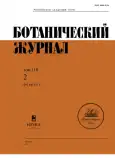Astragalus ferdowsi-toosii (секция Dissitiflori, Fabaceae) – новый вид из Северо-Восточного Ирана
- Авторы: Ghahremaninejad F.1, Joharchi M.R.2, Memariani F.2
-
Учреждения:
- Университет имени Хорезми
- Мешхедский университет имени Фирдоуси
- Выпуск: Том 110, № 2 (2025)
- Страницы: 212-219
- Раздел: СИСТЕМАТИЧЕСКИЕ ОБЗОРЫ И НОВЫЕ ТАКСОНЫ
- URL: https://gynecology.orscience.ru/0006-8136/article/view/680816
- DOI: https://doi.org/10.31857/S0006813625020073
- EDN: https://elibrary.ru/DMUPCI
- ID: 680816
Цитировать
Полный текст
Аннотация
Описан новый вид астрагала из провинции Хорасан-Резави (Северо-Восточный Иран), A. ferdowsi-toosii, названный в честь персидского поэта Абулькасима Фирдоуси (ок. 940–1020). Новый вид является локальным эндемиком высокогорий Zarnikh Mount близ города Кашмер. Характерный признак A. ferdowsi-toosii – сильно вздувающаяся чашечка – свидетельствует о формальной принадлежности к секции Cystodes Bunge, в настоящее время вошедшей в секцию Dissitiflori DC. Авторы сравнивают признаки близких видов A. vesicarius, A. medius, A. albicaulis в сводной таблице. Популяция A. ferdowsi-toosii требует охраны, по наблюдениям 2023 г. на нее негативно влияет продолжительная засуха последних лет.
Ключевые слова
Полный текст
Об авторах
F. Ghahremaninejad
Университет имени Хорезми
Автор, ответственный за переписку.
Email: fgh@khu.ac.ir
ORCID iD: 0000-0001-5860-9976
Иран, Южный просп. Мофаттеха, 49, Тегеран, 15719-14911
M. R. Joharchi
Мешхедский университет имени Фирдоуси
Email: joharchi@um.ac.ir
ORCID iD: 0000-0003-3714-2523
Иран, пл. Азади, Мешхед, пров. Разави Хорасан, 9177943354
F. Memariani
Мешхедский университет имени Фирдоуси
Email: memariani@um.ac.ir
ORCID iD: 0000-0001-5478-1859
Иран, пл. Азади, Мешхед, пров. Разави Хорасан, 9177943354
Список литературы
- Amiri M.S., Mehrvarz S.S., Memariani F., Joharchi M.R. 2022. Vascular flora of Zarrin-Kuh protected area in Central Kopet Dagh Mountains, NE Iran: An annotated checklist. – Phytotaxa. 574(1): 32–60.
- Azani N., Bruneau A., Wojciechowski M.F., Zarre S. 2017. Molecular phylogenetics of annual Astragalus (Fabaceae) and its systematic implications. – Botanical Journal of Linnean Society. 184: 347–365. https://doi.org/10.1093/botlinnean/box032
- Azani N., Bruneau A., Wojciechowski M.F., Zarre S. 2019. Miocene climate change as a driving force for multiple origins of annual species in Astragalus (Fabaceae, Papilionoideae). – Molecular Phylogenetics and Evolution. 137: 210–221. https://doi.org/10.1016/j.ympev.2019.05.008
- Bunge A. 1868. Generis Astragali species gerontogeae. Pars prior, claves diagnosticae. Mémoires de l’AcadémieImpériale des Sciences de Saint Pétersbourg. – Septième. 11(16): 1–160.
- De Candolle A.P. 1825. Prodromus Systematis Naturalis Regni Vegetabilis 2. Parisii: Sumptibus Sociorum Treuttelet Würtz. 644 p.
- Ghahremaninejad F. 2004. Value of trichome characteristics for separating of bifurcating Astragalus (Fabaceae) on sectional level. – Turkish Journal of Botany. 28(1/2): 241–245.
- Ghahremaninejad F., Nejad Falatoury A., Memariani F. 2020. Typification and an emended description of Astragalus moussavii (Fabaceae, Papilionoideae). – Phytotaxa. 441(1): 60–68. https://doi.org/10.11646/phytotaxa.441.1.5
- Ghahremaninejad F., Joharchi M.R., Fereidounfar S., Hoseini E. 2016. Astragalus orientopersicus, sp. nov. (Fabaceae), a new taxon from the Khorassan province (Iran). – Adansonia. 38(1): 29–33.
- Ghahremaninejad F., Joharchi M.R., Memariani F. 2022. Astragalus durandianus (sect. Trachycercis) as an Iranian endemic species: emended description, distribution, and conservation. – Phytotaxa. 550: 32–44.
- Hassanpour S., Moazzeni H., Sonboli A., Hoseini S., Pirani A., Joharchi M.R., Oberprieler C. 2023. Molecular and morphological data reveal a new species of Sclerorhachis (Compositae, Anthemideae) and the reassessment of another species of the genus. – Plant Systematics and Evolution. 309(2): 10.
- IUCN (2019) Guidelines for Using the IUCN Red List Categories and Criteria. Version 14. Prepared by the Standards and Petitions Subcommittee.
- http://www.iucnredlist.org/documents/RedListGuidelines.pdf (accessed 10 July 2021)
- Linnaeus C. 1753. Species Plantarum. Vol. 2. Impensis Laurentii Salvii, Holmiae. 639 p.
- Maassoumi A.A., Ghahremaninejad F., Ghahreman A. 2000. Astragalus moussavii (Fabaceae), a new species of Astragalus sect. Xiphidium from Iran, with supplementary notes on the section. – Nordic Journal of Botany. 20: 353–356. https://doi.org/10.1111/j.1756-1051.2000.tb00749.x
- Memariani F., Joharchi M.R. 2017. Iris ferdowsii (Iridaceae), a new species of section Regelia from northeast of Iran. – Phytotaxa. 291(3): 192–200.
- Memariani F., Zarrinpour V., Akhani H. 2016a. A review of plant diversity, vegetation, and phytogeography of the Khorassan-Kopet Dagh floristic province in the Irano-Turanian region (northeastern Iran – southern Turkmenistan). – Phytotaxa. 249: 8–30. https://doi.org/10.11646/phytotaxa.249.1.4
- Memariani F., Akhani H., Joharchi M.R. 2016b. Endemic plants of the Khorassan-Kopet Dagh floristic province in the Irano-Turanian region: diversity, distribution patterns and conservation status. – Phytotaxa. 249: 31–117. https://doi.org/10.11646/phytotaxa.249.1.5
- Memariani F. 2018. Khorassan-Kopet Dagh floristic province (NE Iran, S. Turkmenistan): an edaphic endemism hotspot in Irano-Turanian Region. – In: GYPWORLD: a Global initiative to understand gypsum ecosystem ecology, Abstract Book: 1st Gypsum Ecosystem Research Conference: Gypsum Ecosystems as Biodiversity Hotspots. 3rd–9th June, Ankara, Turkey.
- Memariani F. 2020. The Khorassan-Kopet Dagh Mountains. – In: Plant Biogeography and Vegetation of High Mountains of Central and South-West Asia. Cham: Springer, Cham. P. 93–116. https://doi.org/10.1007/978-3-030-45212-4_3
- Mirtadzadini M., Joharchi M.R. 2017. Jurinea khorassanica sp. nov. (J. sect. Stechmannia, Asteraceae) from Iran. – Nordic Journal of Botany. 35(5): 569–572.
- Nejati Edalatiyan M., Joharchi M.R., Ghahremaninejad F. 2011. Silene ferdowsii (Caryophyllaceae), a new species from Iran. – Annales Botanici Fennici. 48: 155–158.
- Pahlevani A.H., Liede-Schumann S., Akhani H. 2015. Seed and capsule morphology of Iranian perennial species of Euphorbia (Euphorbiaceae) and its phylogenetic application. – Botanical Journal of the Linnean Society. 177(3): 335–377.
- Parvaresh M., Sharifi H., Akbari Moghadam M., Tajbakhsh S., Sadid S., Feyz M. 2017. Biodistribution model of metals and metalloids in Chalpo mineralization area (NE Iran). – The 35th National Geoscience Congress, Tehran, Iran.
- Podlech D., Zarre S., Maassoumi A.A., Ekici M., Sytin A. 2010. Papilionaceae VI, Astragalus IV. – In: Flora Iranica, Lfg. 178. Naturhistorisches Museum, Wien. 430 p.
- Podlech D., Zarre S. 2013. A taxonomic revision of the genus Astragalus L. (Leguminosae) in the Old World. Naturhistorisches Museum, Wien. 2439 p.
- POWO. 2024. Plants of the World Online. Facilitated by the Royal Botanic Gardens, Kew. Published on the Internet. http://www.plantsoftheworldonline.org/ (Retrieved 20 July 2024)
- Rechinger K.H. 1941. Repertorium specierum novarum regni vegetabilis. B.L. Berlin–Dahlem. S. 255.
- Thiers B. 2023. [Continuously updated]) Index Herbariorum: A global directory of public herbaria and associatedstaff. New York Botanical Garden’s Virtual Herbarium. http://sweetgum.nybg.org/ih/ (accessed 15 July 2023)
- Zarre S. 2003. Hair micromorphology and its phylogenetic application in thorny species of Astragalus (Fabaceae). – Botanical Journal of the Linnean Society. 143: 323–330. https://doi.org/10.1046/j.1095-8339.2003.00220.x
Дополнительные файлы












